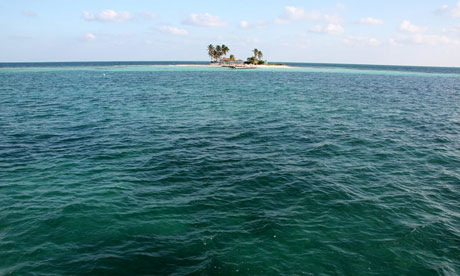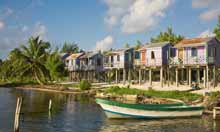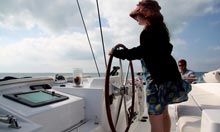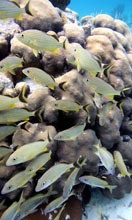The Cayes to happiness: Belize by boat
The former British colony of Belize is largely untouched by tourism, as our writer finds during a catamaran trip exploring the Caribbean coast of mangrove islands and remote reefs

One of thousands of tiny islets south of Ambergris Caye, Belize. Photographs: Kevin Rushby
At the check-in desk in Cancun airport, Mexico, we stare defeat in the face.
"I am sorry," says the man from American Airlines. "But without an Esta form for the United States we can't let you on the flight."
"But we are going to Belize City, not the US."
He shakes his head sadly and glances at the clock. "The flight is routed via Miami and you have to have that form. But anyway the gate is now closed. You've missed it."
Sophie and I turn to one another. We are in Mexico and we're supposed to be in Belize in eight hours' time to meet a yacht that will take us out to the islands. We're 300 miles north of our destination with no local knowledge, contacts or information. We do, however, have an excited seven-year-old.
"Are we lost in Mexico, Daddy?" asks Maddy.
"Yes."
"Cool!"
I wait, expecting annoyance and frustration to come, but they don't. Instead a sense of relief floods through me. All the hassle and rush of the previous, and totally disastrous, hour disappear. Inexplicably, Sophie and I both start laughing. With the flight gone, all that we, and everyone else, hate about modern travel has gone too: the queues, the bullying immigration, the demands to remove your belt, boots and braces. So, Mister Rushby, you are carrying more than 100ml of sun cream? Are you, or have you ever been, an international terrorist?
"There's another flight tomorrow," says the man, but we know what we have to do. Gathering our bags, we walk out into the Mexican sunshine. Glossy blue birds cackle at us from the mimosa trees. A group of people in overalls are laughing as they sit on a kerb waiting for a bus to town. Gold teeth flash in the morning sun. No one speaks English. We have slipped through the grate, dropped out of the industrial process of tourism, and fallen into the real world. A crowd gathers. Digging up a few words of Spanish, we understand that a bus to Cancun coach station will be our first step on this adventure.
Not every trip has such moments. And the capability to plan things minutely these days means they happen less often. But we stood there in the morning sunshine and no car came for us, no one held up a sign with our names, no one stepped forward. On my first ever backpacker foray from home, I got off a plane in Cairo and, not having a clue what to do next, froze. When I did eventually step out into the street, however, I felt liberated: all of Africa before me and a journey waiting to be created. I loved that empty road.
At Cancun coach station I felt that pleasure again. We ate pineapple and mango from handcarts. Maddy's excitement increased: there were cowboys in the street, dusty men with battered faces carrying saddles and wearing Stetsons and tooled boots. No one knew anything about getting to Belize, which lay to the south at the other end of the Yucatán peninsula. The ticket office was mystified. "Take a coach to Chetumal," they advised. "From there the frontier is close, but Belize City …" Shoulders and palms raised, "I don't know. It's jungle. Belize is jungle. There is a road, I think …"
Six hours later in Chetumal bus station we heard another story. "There's a boat."
We went down to the quayside, where the pelicans were cruising past at palm tree height. Every now and again one would suddenly fold itself up and plummet into the sea with an enormous splosh, reappearing seconds later with a flappy, happy, gullet of fish.
A Belizean guy speaking in rich rolling patois accosted us. "You wan' go Belize City? Better you take the boat over to Caye Caulker - that's a lil' island just outside from Belize City. Your boat could meet you there fo' sure."
I'd been trying the number of Cliff, the captain of our yacht, all day, but now, fortuitously, my text message got through and I quickly received a reply. "No problem. We'll be there. Boat's name is Doris."
That was it. A new route pioneered. Fly direct to Cancun, bus to Chetumal, boat to Belize. Easy - and avoiding all the hassles of air routes into the US. Perhaps the six-hour bus ride isn't for everyone - but there were other pleasures. On the jetty, immigration was one man in a shed who played with Maddy's teddy bear and checked we had enough drinking water for the voyage. It didn't seem fair really: we could have been in the Miami airport cage, glowered over by Homeland Security while our suncream was exterminated by the marines.

Beach cabañas at Caye Caulker Photograph: Alamy
It was after dark when we docked at Caye Caulker, a sand spit of palms and clapboard cabins favoured by fishermen and backpackers. Men were playing beach volleyball. One took us across the island - a two-minute shuffle through soft warm sand - to a little jetty. "There's Cliff comin'," he said as a tender detached itself from the large catamaran a hundred yards off the beach and curved towards us under a star-quilted sky.
"Welcome home," called a voice as it got nearer. "Is lobster OK for dinner?"
Belize is one of those forgotten corners of our former empire that we ought to have a close relationship with, but don't. "Belize?" Someone said to me before our trip, "Isn't that in Africa?" In fact it's a central American country the size of Wales with a population the same as London - in 1640 (around 300,000). It's got jungles, beaches, islands and more ancient Mayan buildings than modern ones. It does not have a single multinational chain: no Starbucks, McDonald's or Tesco. It's a place that attracts the eccentric, the drifter, the adventurer - anyone sick of corporate rule-bound cack - which is not much different from the 17th century, when it drew British pirates hiding from the Spanish. In the late 1950s it even managed to pull in a large population of those perennial utopians, the Mennonites, who still ride around in horse-drawn buggies wearing belts, boots and braces - and no one ever demands they be taken off.
That night, sitting on deck gazing at the sky, Cliff told me how 10 years ago he escaped San Francisco to sail here, and never looked back. He or his father - referred to as Big Cliff - picks up guests on one of three catamarans, then sails around the keys and lagoons.
"I love it," said Cliff, and I believed him. There were three others on board: Rachael, our chef and the brains behind start-up travel company Absolute Belize, and her friends Amy and Angus. The latter was in heaven, literally. A keen astronomer, he'd come from the neon-smeared skies of London to this. Binoculars glued to our faces we lay on our backs and marvelled. We spent that first evening finding Andromeda, a sparkling spiral of light in the constellation Pegasus (you can find it from the UK, too).
"That is one trillion stars," said Angus. "And in a few billion years we are going to smash into it. Shall we open that bottle of 21-year-old rum?"
 Maddy takes the wheel of the catamaran.
Maddy takes the wheel of the catamaran.
So began an idyllic few days. The next day we sailed for the Drowned Cayes, an area of mangrove islands where manatees raised themselves up from grazing on sea grass to look curiously from the water at us. These lugubrious giants are thought to be the origin of the mermaid myth but actually seem more like overweight dolphins, dozing in the shallows. Maddy and I kayaked through narrow green tunnels of mangroves, watching tiger herons send tiny fish skittering across the surface. For the most part Belize has had the good sense to preserve these natural hurricane breakwaters and we saw only one where an ignorant owner had chopped down his mangroves, then seen his island start to disappear and been forced to build an ugly sea wall.
Back on the catamaran, we sailed on, catching tuna and Spanish mackerel as we crossed deeper water, and reached a lonely atoll topped with six palm trees, an outpost on the world's second-longest barrier reef. Cliff and I examined the charts, myriad tiny islets and bays with a bizarre selection of names, tribute to the humour and the prosaic natures of their discoverers: Wee Wee Island, Man-O-War Caye, Mosquito Caye, Tom Owen's Caye.
Rachael came to this part of the world two years ago after a chance meeting with a school friend. "With all the historical links it seems strange there aren't more British tourists," she says. "It's relatively crime-free, they speak English, and it's as pretty as anywhere in the Caribbean."
A troubled past may play a part in that. There were border disputes with Guatemala in the 1980s, and Belize City has a reputation, not wholly undeserved, for violence. Poor regional communications have probably done the rest. At the moment the country seems to attract relatively affluent but adventurous backpackers who come down from Mexico, as we did, and then move on to Guatemala. Some tourists also come to two luxury lodges, Turtle Inn and Blancaneaux Lodge, owned by film director Francis Ford Coppola

San Pedro,on the northern island of Ambergris Caye, is the only place approaching a resort, though there are no big hotels, and little desire to build any. The best place here to sample creole cooking is El Fogon or, further north along the beach, the smarter Rojo Lounge. Most visitors come to snorkel at Hol Chan Marine Reserve or dive at the Blue Hole, a deepwater cave. Bu the southern half of the country barely sees a tourist, despite having amazing islands and jungle mountains full of Mayan ruins.
It was the south I wanted to reach, and next day we sailed on, exploring reefs and atolls where frigate birds soared like Jurassic monsters. Before the trip Maddy had declared she would never swim in water where there were any fish. Now, with some of Cliff's endless patience, she was encouraged to snorkel, spotting rays, groupers, even the occasional shark. The sea here is so shallow that even the most cautious swimmer can enjoy what is below by simply donning a face mask.
At last we arrived at South Water Caye, where Cliff dropped anchor at sunset and suggested we wait until the moon went down before swimming. At 10pm, finally, the silvery lunar disc slipped into the waters and I dived overboard and into the most astonishing of swimming experiences.
As my body hit the water, it exploded in light, streams of scintillating green and blue sizzling from my fingertips and sending out great curving constellations of phosphorescence. Diving down I blew bubbles and watched as they were lit by the same eerie light. Further below were strange discs of light - fish? - and other fractal flashes in the gloom. This is bioluminescence: marine bacteria and plankton that release a chemical called, appropriately, luciferin, when they are touched. Cliff claims he has never visited the anchorage without the phenomenon appearing.
Eventually, after a long and unearthly swim through this cosmic cloudburst, I climbed out on the deck and lay down for a star bath. Industrial tourism seemed further away than the Orion nebula to which our masthead, a gently swaying finger, pointed.

